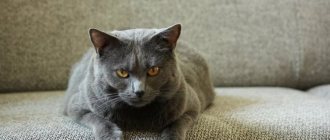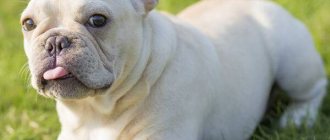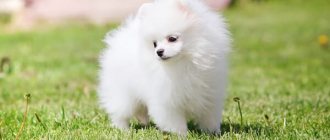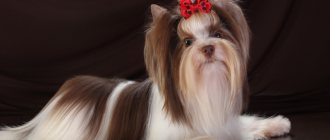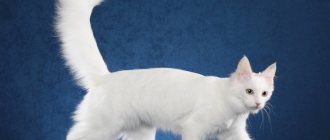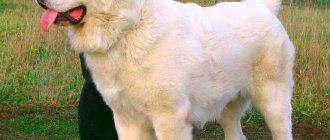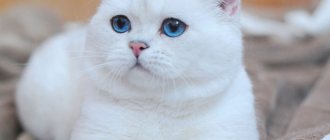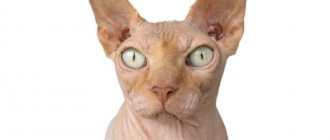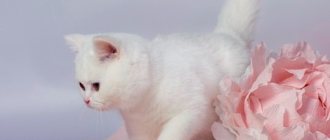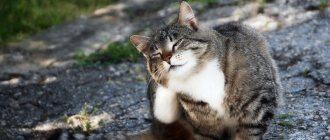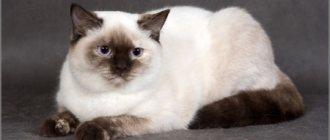British among cats
This breed is popular due to its independent and patient disposition, because British women will never get bored in the absence of their owner. At the same time, plush purrs are not devoid of a sense of tact and show full love to those who take care of them and treat them with tasty treats.
British cats are the embodiment of calm and intelligence
The British are distinguished by high intelligence - by changing the “notes” in the breadwinner’s voice, the cat will understand that it is doing something wrong. However, these little cats cannot be called too mischievous or vindictive - calmness is their strong point. At the same time, British cats are not inclined to become toys in children's hands; with excessive attention from children, the cat will prefer to run away.
Externally, British catfish differ in the following parameters:
- thick coat with dense undercoat;
- round, close-set eyes of amber color;
- massive head on a short neck;
- wide cheekbones;
- small nose with a wide bridge;
- ears widened at the base with rounded tips;
- muscular body on wide, strong legs;
- medium-length tail, rounded at the end.
Types of tabby patterns
There is a classification of tabby patterns, which includes 4 main types: ticked, striped, classic and spotted. They are also called Abyssinian, mackerel, marbled and leopard, respectively.
Table 1. Tabby color types
| Color name | Ring pattern on neck and tail | Drawings on the torso |
| Ticked | Almost invisible, not pronounced in all breeds. The tip of the tail is predominantly dark | The presence of so-called “freckles”, also faintly expressed |
| Striped | Narrow frequent stripes | Thin stripes, often repeated throughout the body, as well as along the vertebral ridge |
| Classical | Large, not always clearly defined | Wide, uneven stripes with curves, spots, and intermittent areas |
| Spotted | Wide, not very visible, interrupted, open | Spots of varying sizes creating the appearance of broken lines |
Ticked
The most subtle and inconspicuous of all tabby colors. At first glance, it seems that such cats are monochromatic - the pattern is clearly expressed only on the face, paws and tail, but the color of their coat is not uniform. There are light stripes, spots or “freckles” throughout the body, which differ from the main color by only a few tones. Mostly representatives of the Abyssinian breed have a similar color, which is why the ticked color received such a second name.
Ticked is the most inconspicuous of all tabby colors.
Striped
The brindle or mackerel color is characterized by the presence of bright narrow stripes, often repeated throughout the body. This type received its second name due to a certain similarity with the color of mackerel - striped fish. The pattern is clearly defined, often starting at the ridge line, going down to the belly in numerous branches. The color of the stripes clearly contrasts with the main color of the coat.
The mackerel color is clearly visible on the cat's fur.
Classical
Marble pattern is considered one of the most beautiful. Wide linear, spiral or graphic patterns have indistinct outlines on the neck and paws, becoming more pronounced on the back and sides of the animal. The body is often decorated with large spots, curls, uneven patterns, designs reminiscent of human eyes, butterfly wings, and oyster valves. The color of the patterns clearly contrasts with the main tone of the coat, which can be any shade except white.
Marbled Tabby
Spotted
The stripes of spotted cats are practically absent and are intermittent and short. The patterns predominantly consist of successive dots, spots and blots. The color of the patterns is bright, slightly or very different in tone from the main color of the coat. Representatives of this type resemble small leopards.
Spotted tabby color
Rarer variants
Although most tabby cats fall under the above classification, there are many exceptions that do not fit into this classification. In the variety of designs and shapes, one can highlight examples of rare beautiful types:
- rosette Looks like leopard print. The spots are larger, have a clear edge of a darker color in the form of an uneven outline and a lighter center. Both tones are usually different from the base coat color;
- tortoiseshell. The uniqueness of the tortoiseshell tabby is that the main color of the animal is two-color (black and yellow shades, as a rule). The drawing does not have a clear order and is not expressed too clearly;
- calico. A third primary color is added - white (on the paws, chest, tail or muzzle, as a rule). The pattern looks more like spots or short thin stripes. Because of this, the second name for the color is spotted with white;
- patched Combines the characteristics of the two previous subspecies. A cat can be both tri-colored and white and spotted, with very large spots alternating with each other like patches. In each individual spot, both the main color and the color of the pattern change. The color is found predominantly in cats;
- links point. The cat seems to have accents from the drawing. Moreover, only some details are painted (muzzle or ears, tail, paws, chest or spine line).
How the color of the Briton was formed
There are several versions of the origin of the breed - one says that the ancient Romans brought cats from the Egyptian desert in the 1st-2nd centuries. ad. According to another legend, British cats originate from the purring Chartreuse breed, taken by medieval crusaders from the shores of South Africa.
Chartreuse cats are considered possible ancestors of the British breed
The first true Britons who settled Foggy Albion had gray-blue “stuffed” fur. This is how they were depicted in religious treatises (for example, in the Lindisfarne Gospel), poems and bestiaries. Zoologists began selection, which fixed the color, only in the 19th century, at which time the first breed standard was drawn up.
Color is the color scheme and patterns on a cat's fur coat that are formed as a result of the interaction of genetic materials responsible for the production of melanin in the body. The desired shade of coat is obtained by crossing animals with dominant and recessive genes responsible for the pattern and depth of tone. So, in British dogs with blue hair, the set of genes looks like BBdd (where B is the dominant gene that forms the black color, and d is the recessive gene responsible for muted, diluted shades). Marbled cats carry the Tb gene (where T is the dominant tabby color gene, and b is a recessive gene that makes the coat brownish, not black).
Felinologists became concerned with professionally establishing breed characteristics (including color) in British cats only after the Second World War, when the question arose of preserving this variety of domestic purrs:
- 1950 - official recognition of the British Blue breed;
- 1967 - British blue cats received the champion title from the ACA association;
- 1977 - ban on mating with other breeds, including Chartreuse;
- 1980 - recognition of the breed by the CFA Association.
External differences
Granite is a rock that is of igneous or metamorphic origin. Characterized by a grainy pattern, it consists of quartz, mica and feldspar. It is most common with a light gray color, but its composition can contain many different impurities, so yellow granite, red, bluish, pink and green are found.
Marble is a natural material formed as a result of metamorphism (recrystallization) of carbon-containing compounds (dolomite, limestone). Its composition does not change during the process. By color there are white, gray, yellow, brown, black, green, pink, blue marble, as well as various combinations of these shades.
Colored versions of the material look most original - the presence of veins in the form of cracks filled with natural cements creates unique patterns on the surface of marble. Its true color and pattern appear after polishing.
General technical differences
The strength of granite is several times greater than marble - it is characterized by increased resistance to abrasion, friction and compression. It is also characterized by high levels of hardness and density. It is processed using diamond, and it is possible to achieve a mirror polishing of its surface.
Other distinctive features of these stones:
- The first signs of destruction on high-quality granite appear only after 500 years of operation.
- The service life of white marble is hundreds of years - the first signs of changes appear after 150 years.
- Granite does not require additional protection from acids and is resistant to mechanical damage.
- Marble has a more uniform structure due to uniform grain size and the absence of large inclusions.
- Granite can withstand over 300 freeze and thaw cycles, making it ideal for outdoor applications.
- Marble is more plastic, so it lends itself better to grinding and polishing. And the increased viscosity with sufficient strength makes it resistant to impacts and allows you to create products of complex shapes.
- Optimal types of granite
- Types of granite monuments
- Conclusion
When deciding whether granite or marble is better for a monument, it is important to understand the characteristics of each type of natural stone. Marble and granite have significant differences not only in appearance, they differ in strength and other physical characteristics
We suggest you figure out in which cases marble is chosen, and in which granite.
It is known that marble sculptures are distinguished by high artistry and excellent quality of processing. Expressive statues and complex bas-reliefs are carved from marble. Granite, on the contrary, is more difficult to process, but looks great when creating monuments and obelisks.
Where does the British marbled cat come from?
Since the beginning of the 20th century. British cats included not only plain blue animals, but also tabby cats with different shades on their fur coats. Thus, in 1901, American felinologists registered a Belle cat with a red tabby color.
British marbled cats appeared as a result of crossing with other breeds
The consequence of two world wars was the almost complete extermination of the British breed, so breeders began to crossbreed pets with representatives of other varieties - Burmese, Russian Blues, Persians and Scottish. The result was the appearance of many varieties of British color while simultaneously preserving the breed characteristics (wide paws, protruding cheekbones, “plush” coat).
At the same time, among all the variations of the striped coat of the British fur coat, it is the marble color that is considered classic, occurring naturally. Zoologists are inclined to believe that the symmetrical darkening on the fur of catfish from Foggy Albion is an inheritance from wild Asian or African ancestors.
Life in the wild
Modern scientific observations of a rare species of felines are taking shape literally bit by bit. A lot of valuable data was obtained when a special chip was implanted in a wild-caught marbled cat in 2000. Episodic information is also obtained from video cameras that are installed in many reserves and record the life of the animals living there.
Rare footage from a surveillance camera
Where does the marbled cat live?
The favorite habitats of Pardofelis marmorata are impenetrable tropical forests, away from human paths and dwellings. But some small populations willingly settle in high mountainous rocky areas, where any vegetation is practically absent. The territory that one animal “superses” is about six square kilometers.
The marbled cat spends most of its life in trees
Lifestyle and character
Marbled cats are unsurpassed steeplejacks; they move much less often on the ground than on the branches of tall trees, flying up their trunks with lightning speed at the first need. Here, in the tree crowns, under the cover of dense foliage, a significant part of the marbled cat’s life takes place. She leads an exclusively nocturnal lifestyle, and during daylight hours she sleeps, sitting comfortably on the branches.
It is interesting that forest predators, unlike other felines, are exclusively ready to go down. At the same time, their movements are precise and swift, like those of squirrels.
She kind of looks like a squirrel, doesn't she?
Hunting is the main essence of the marbled cat; both its strong body and its entire way of existence are ideally suited for this activity. This ideal huntress can lie motionless for hours, like a statue, waiting for her prey to appear. But as soon as the right moment comes, the predator makes a killer throw - lightning fast and accurate; Almost all of her attacks are effective.
The marbled cat is also excellent at tracking down prey - here its excellent sense of smell and acute vision become its faithful assistants: the animal sees well in the dark.
Video: marbled cat walks through the forest
Nutrition
The diet of the marbled cat is very varied, and it supplements its menu by mainly hunting in the crowns of trees. Here, tree squirrels, bats, and, of course, various birds can become predator trophies. On occasion, she will not refuse to feast on other small prey: rodents, amphibians, reptiles and even large insects, which are found in abundance in the tropics.
The marbled cat hunts not only in the crowns of trees, but also in reed thickets
These cats have a good appetite - the daily diet of the predator reaches up to 0.8 kilograms in weight, which is approximately a sixth of the live weight of an adult animal.
Reproduction
These animals spend most of their lives alone: controlling the borders of their territory and protecting them from the invasion of strangers. But once a year, a marble cat and a female cat meet to indulge in the joys of love. And in this most important intimate matter, they also differ from most of their relatives. This species does not have a mating season determined by the time of year - a couple is formed when a mutual desire arises.
Lovers fill the tropical forest with romantic songs—loud guttural purrs; in normal times, these predators simply meow - just like the most common domestic pussy.
The season of love for marbled cats occurs at any time of the year.
In preparation for giving birth, the expectant mother cat begins to arrange a den in advance in which she will raise her offspring. The most inaccessible place for the nest is selected: in the hollow of an old tree or a cave hidden in dense grass thickets.
Pregnancy in a female lasts slightly longer than in other representatives of the cat family - up to 85 days. At the time prescribed by nature, blind, deaf and helpless kittens will be born - there are rarely more than four of them in a litter, and at first they look completely unmarbled. At birth, babies weigh no more than one hundred grams. And the first fur of newborn cubs has a uniform brownish tint; beautiful dark stains will appear on it much later, by four months.
By four months, the kitten's baby fur has completely changed to that of an adult.
Sexual maturity in young animals occurs at approximately two years. From this age they are ready to mate and give birth to offspring. How cubs are raised in nature and whether the father of the kittens is involved in this is unknown to zoologists today. The mother feeds the babies milk until they are two months old, then switches them to “adult” food, and at the same time teaches them all the intricacies of hunting and survival.
Main threats
The main risks for the existence of the marbled cat are human economic activity - deforestation and the development of the ancestral territories of the wild species.
The marbled cat's natural enemies are larger predators, mainly its fellow cats living in the same region. The wild Bengal cat, whose habitats often overlap in the marble cat, could compete in terms of food supply. But the first of the small predators hunts only on the ground, and the second - mainly on the upper tier of the tropical forest.
The masterly ability to climb trees helps not only to hunt, but also to escape from other predators.
Video: a selection of video surveillance from the reserve
Types of merle colors among the British
This color belongs to a group of colors called tabby (from the name of the striped fabric brought to England from Baghdad). The peculiarity of this pattern is the continuity of lines and the uniqueness of the pattern for each individual. Thanks to the efforts of felinologists, today the British marble coat is represented by many varieties.
Black marble
The main background of the coat is dark gray, the stripes have a pronounced black tint. There is a black outline around the eyes and nose, the color of the eyes is brown-orange.
British black marble shades are highly prized by animal lovers.
Black marble on silver
Charcoal stripes and spirals are symmetrically arranged on a silver background. There are dark spots near the eyes and the red-brown nose.
Black marble on silver - exquisite colors of British cats
Black marble on gold
The main color of the coat is copper-golden, the stripes have a black or dark brown tint. The eyes are most often green or yellow.
The British with the “black marble on gold” color look very presentable
Lilac marble
The silver fur coat is decorated with patterns of lavender or peach undertones. There is also a lavender rim around the nose and eyes. The iris is yellow or pale brown.
British cats with a lilac-marble hue are quite unusual
Tortoise marble
The main background can be silver-red or silver-brown, while the spots and patterns remain black or dark brown. The eyes are often yellow or greenish. The color is characteristic only of females; in rare cases it is found among males. Cats with this color cannot have offspring due to genetic characteristics.
Tortoiseshell marble involves adding reddish shades to the main color scheme
Chocolate marble
The fur coat is the color of milk chocolate, the pattern is dark brown. The eyes and nose are outlined with thick chocolate eyeliner. The color of the iris is from yellow to golden brown.
Chocolate Marble is a common color option among the British.
Bicolor
The main color with spots is diluted with white inserts on the paws, chest and belly. Eyes can be yellow, brown or green.
Bicolor color is also found among British harlequins.
Red marble
The light red fur of the main background is decorated with spots and streaks of a rich red hue. The eyes are orange, brownish-golden.
Red merle is a red British breed with merle patterns on their coats.
Red marble on silver
It is distinguished by a silvery tone of the main background, the spots have a light red color. The fur around the eyes is white, the nose is pink. The eyes are yellow or golden.
Red marble on silver - a spectacular coat color for the British
Cream marble
The main background has a shade of creme brulee, and the spots tend to be peach. There are white hairs around the eyes and a pink nose. Eyes yellow or gold.
Cream marble is a very delicate shade of the fur of British cats.
Blue marble
Silver coat with smoky gray stripes and spots, dark gray lining around the nose. The eyes are not circled and have a brown-golden tint.
The British in the shade of “blue marble” look noble
Description
Marble chips are a natural mineral, crushed to the state of flour or crystals, the size of which on average varies from 0.5 to 2 cm. The particle size is determined by the external section. During production, the material goes through the stages of drying, dust removal and sorting. Outwardly it resembles sand, but in origin it is a crushed stone.
The mineral is mainly mined in quarries in the Trans-Urals, Western Siberia, Altai, and Krasnoyarsk Territory. The stone itself is formed by combining rocks under pressure and high temperature. It can have different densities and consists of dolomite, calcite or a combination of both. It may contain suspensions of organic origin, which determine the shade of the mineral.
Marble chips are made from illiquid pieces of marble, as well as its waste. The product that meets the requirements of GOST 22856-89 goes on sale. The size of the granules is directly related to the mass: the larger the crumb, the more it weighs.
Marble color standards
In addition to the basic standards of the breed, additional requirements have been established for British merles, which must be present in the exterior. The absence of at least one sign leads to the culling of the pet and the inability to participate in further breeding.
Marble British should have a clear pattern
Interestingly, the classic letter “M” on the forehead of tabby cats is associated with the prophet Mohammed. Allegedly, when the saint picked up a marble cat, the hair on its head became colored in a specific way. Which became a sign of the Higher Powers’ love for these purrs.
So, the marbled British cat is distinguished by the following characteristics:
- brightness, symmetry and clarity of the pattern on the fur coat;
- absence of intersections and broken lines in the patterns;
- the hairs are colored in two ways (in several shades - the hairs of the main background, in one color - the hairs of the patterns);
- the color of the iris depends on the shade of the coat; it can be copper, hazel, greenish or brown;
- there are “necklaces” on the chest, and two dark curls running parallel on the cheekbones;
- the forehead is marked with a pattern in the shape of the letter “M”, on the back of the head and shoulders there is a pattern in the form of a butterfly;
- the outer side of the ear closer to the base has a white spot;
- three long stripes of distinct dark color stretch along the ridge;
- the hips are marked with circular closed patterns;
- the tip of the tail is always marked in a dark color;
- There is a bright outline around the eyes and nose.
In addition, a classic marble cat should have small, far-set ears and massive paws. At the same time, the color of the skin on the pads of the paws, as well as on the nose, depends on the color of the animal’s fur - the darker the fur, the richer the skin tone. Seals with a silver background have pink paws and noses, red ones have crimson purrs, and “dark” British cats are completely brownish.
Table: EMS codes for coat colors in cats
| Code number | Transcript (in Russian) | Transcript (in English) |
| Main color | ||
| a | blue (blue) | blue |
| b | chocolate (Havana, brown, champagne, chocolate) | chocolate (brown, chestnut) |
| c | lilac (platinum, lilac, lilac) | lilac (lavender) |
| d | red (ed) | red (flame) |
| e | creamy | cream |
| f | black tortoiseshell (sil-torti, tortoiseshell) | tortoiseshell |
| g | blue tortoiseshell (blue-cream tortoiseshell, blue cake) | blue-tortie (blue-cream) |
| h | chocolate turtle (chocolate cake) | chocolate-tortie |
| j | lilac tortoiseshell (lilac-cream tortoiseshell, lilac-torty) | lilac-tortie |
| m | caramel | caramel |
| n | black (ebony, sable, wild, seal) | black (ebony, sable, ruddy, seal) |
| o | cinnamon (sorrel, honey) | cinnamon (sorrel, honey) |
| p | faun (beige, fawn) | fawn (beige) |
| q | Tortoiseshell cinnamon (cinnamon cake) | cinnamon-tortie (sorrel-tortie) |
| r | tortoiseshell fawn (fawn-tortie) | fawn-tortie |
| s | silver | silver |
| t | amber (amber) | amber |
| w | white | white |
| y | gold | golden |
| x | unregistered color | unregested |
| Degree of white spotting | ||
| 01 | van | van |
| 02 | harlequin | harlequin |
| 03 | bicolor | bicolour |
| 04 | bicolor for color points | mitted\white point |
| 05 | snowshoe | snowshoe |
| 09 | small white spots | little white spots |
| Tipping degree | ||
| 11 | shaded (shaded, shedded) | shaded |
| 12 | chinchilla (veil, veiled, tipped, shell) | tipped (shell) |
| Type of drawing | ||
| 21 | tabby, agouti | tabby (agouti) |
| 22 | marble (marble) | blotched (marble, classic) |
| 23 | tiger (mackerel) | tiger (maskerel) |
| 24 | spotted (rosette) | spotted |
| 25 | ticked | ticked |
| Acromelanic colors | ||
| 31 | Burmese (sepia) | burmese (sepia) |
| 32 | Tonkinese (mink, mink) | tonkinese (mink) |
| 33 | Siamese (Himalayan) | siam (himalayan) |
| 34 | Singaporean | Singapore |
| Tail length | ||
| 51 | rampy | rumpy |
| 52 | ramp riser | rumpy riser |
| 53 | stumpy | stumpy |
| 54 | longs | longy |
| Eye color | ||
| 61 | blue | blue |
| 62 | yellow | yellow, golden |
| 63 | disagreement | oddeyed |
| 64 | green | green |
| 65 | Burmese color | burmese color |
| 66 | tonkinese color | tonkinese color |
| 67 | siamese color | siam (himalayan) color |
| Ear shape | ||
| 71 | straight | straight |
| 72 | curl | curled |
| 73 | fold | fold |
| Coat type | ||
| 81 | long wool | longhair |
| 82 | short hair | shorthair |
| 83 | brush | brush |
| 84 | straight | stright |
Shaded and veiled colors (“chinchillas”)
Silver and golden “chinchillas” are very beautiful, highly valued colors of the British. The name of the color is given because the cats' fur coloring resembles chinchilla animals.
Silvers have a snow-white undercoat, and at the tip of the guard hairs there is a black or blue “spraying”. Yellowness is not allowed. Eyes are green. According to the degree of coloring of the guard fur there are:
- Silver shaded. Only the upper ⅓ of the guard hair is colored, which creates the impression of a “sprayed” color. The undercoat is completely white.
- Silver veiled. The upper ⅛ of the guard hair is colored. It gives the impression of a white cat in a light silver “veil”.
Golden chinchillas have a soft apricot undercoat and a black or blue-gray coat. The brighter the “gold” glows, the more valuable the kitten. Gray inclusions are not allowed. The color of the iris is green. Golden chinchillas are also divided according to the degree of coloring of the guard hairs:
- Golden shaded. The undercoat is peach to apricot in color. The guard hair is colored ⅓ at the tip.
- Golden veiled. The undercoat is peach. The guard hair is colored ⅛ at the apex.
Photos of British silver chinchillas:
Photos of British golden chinchillas:
Anomalies and features of merle color in the British
A plush fur coat with streaks and patterns reminiscent of a cut on marble is considered one of the most difficult in terms of proximity to standards. If you plan to purchase such a kitten, breeders and experienced owners recommend taking a baby no younger than 4–6 months of age. By this time, the pattern on the coat will be completely formed and the slightest deviations from the norm will be noticeable.
British merles have the same developmental anomalies as other cats.
At the same time, British harlequins have clearly marked stripes and circles on their coats from birth. If the degree of coloration of the hairs in the pattern is excessive, then the final pattern will be blurry. Then they talk about “false marble”, or moire, among the British. This is an anomaly due to which the animal is not allowed to be bred.
Disadvantages that reduce points at exhibitions:
- torn edge of the pattern;
- The picture is too large and overlaps the main background.
Anomalies leading to a ban on procreation:
- polydactyly;
- too many rings around the eyes;
- kinks on the tail;
- disorders in the structure of the jaw.
Mr. Cat Recommends: False Marble
With a tabby pattern, each hair is ticked and painted in several colors. If it is excessive, the marble pattern turns out to be shaded, as if supported by a film or fog.
This blurriness is called moiré or false marbling in the British breed.
For Bengals, this phenomenon is called phasing, and it has a different character. The ticked undercoat covers the main color, but it definitely goes through. Moreover, it is marbled kittens that flourish earlier than others - spotted, rosette.
But British moire patterns can remain “shaded” for life. No one can predict whether a baby will get ticking or not. Therefore, it is better to purchase marbled British kittens, straights or Scottish, later - by 4-6 months.
Caring for the British Marbled's fur coat
The breed is one of the cleanest and neatest cats, so the animal often takes care of its appearance on its own. At the same time, it is recommended to wash the cat every six months and comb its elegant fur at least once a week.
British marble cats do not require special care
Since the coat of British cats is quite elastic and flexible, there are no special rules for caring for it. It is recommended to regularly clean the animal’s ears (with cotton swabs dipped in warm water) and the animal’s eyes (with warm and damp cotton pads) - every 7-10 days.
Video: British marbled cat
Briefly about the main thing
Marble chips are essentially a by-product of marble extraction, which is widely used in landscape design. The material is quite varied. Raw materials of different fractions and different colors are available for sale; they all give the landscape a natural, harmonious look.
Thanks to the physical properties of marble, stone filling is strong and durable, does not fade in the sun and does not collapse after a frosty winter. Marble chips are usually used to form paths and platforms; they are used to decorate flower beds and rock gardens, and to mulch plantings. The material should be laid on a prepared base, preferably reinforced with a layer of geotextile.
Knitting features
The British merle color is one of the most difficult to breed due to the high degree of moire among the offspring. Felinologists still cannot track the pattern of appearance of vague patterns. The most common reason is the crossing of a merle parent with a solid-colored Briton.
British marbled cats can only be knitted with each other
Everything is explained by the genetics of color - the gene responsible for the merle pattern is recessive, and the gene for uniform color easily overlaps it. Therefore, in order to preserve breed characteristics, it is important to breed only between British Marbleds. In exceptional cases, crossing with representatives of the breed that have a tiger (mackerel) color is allowed.
Character of the breed
Marbled Scots have the character of typical representatives of the breed and do not inherit global changes in habits. Just like the Scottish Fold, they are smart, good-natured and playful, and their unusual coloration only adds zest to the general characteristics of the breed.
All Scots have a calm and homely disposition.
Scottish cats love the company of people very much; they are equally happy with their owner, family members, guests and small children. Sometimes it is difficult to imagine a breed that would be more patient and accommodating when dealing with small children. The same applies to other pets, to which the friendly Scot will show a healthy interest and his childish enthusiasm.
Scottish kittens get along quickly with small children and other pets
Scottish marbled cats love affection very much; they can spend hours basking in the arms of someone who will stroke them and ruffle them behind the ears. They are always an object of admiration and will never cause a headache.
To the exhibition with the marble Briton
Since British cats were officially recognized as a breed back in the 1980s, these purrs regularly participate in advertising shows, seminars and exhibitions. Marble Britons were no exception.
British marbled cats are regulars at exhibitions and shows
Before sending your pet to a competition, it is necessary to carry out hygiene procedures - wash the animal, clean the eyes and ears, and comb the hair thoroughly. You also need to carefully trim the tips of the claws and give the fluffy a little sedative before the trip (1-2 drops of valerian).
To participate in the exhibition you must meet a number of requirements:
- have a veterinary passport and a document about the origin of the cat;
- the animal must be completely healthy;
- Murka should not have fleas and other parasites;
- The minimum age of a cat is limited to 3 months.
The British Marble will not be allowed to compete if:
- aggressive behavior;
- deafness;
- the presence of tattoos and other interventions in appearance.
Choose which kitten to buy
| № 847 Scottish Straight Age: 2 months price: more about the kitten | № 846 Scottish Straight - Scottish Straight Age: 3 months price: more about the kitten |
№ 845
Scottish Fold Age: 2 months
price:
28,000
rub.
more about the kitten
№ 844
Scottish Fold Age: 2 months
price: inquire (916)1737752
more about the kitten
№ 842
Scottish Straight Age: 2 months
price:
20,000
rub.
more about the kitten
№ 840
Scottish Fold Age: 2 months
price:
28,000
rub.
more about the kitten
№ 839
Scottish Fold Age: 1.5 months
price:
30,000
rub.
more about the kitten
№ 838
Scottish Fold Age: 1.5 months
price:
15,000
rub.
more about the kitten
№ 837
Scottish Straight Age: 1.5 months
price:
15,000
rub.
more about the kitten
№ 836
Scottish Straight Age: 3 months
price:
20,000
rub.
more about the kitten
№ 835
Scottish Straight Age: 4 months
price:
22,000
rub.
more about the kitten
№ 834
Scottish Straight Age: 2 months
price:
20,000
rub.
more about the kitten
№ 832
Scottish Fold Age: 2 months
price:
28,000
rub.
more about the kitten
№ 831
Scottish Straight Age: 2 months
price:
15,000
rub.
more about the kitten
№ 830
Highland straight Age: 2 months
price:
15,000
rub.
more about the kitten
№ 826
Scottish Fold Age: 2 months
price:
20,000
rub.
more about the kitten
№ 824
Scottish Straight Age: 18 months
price:
20,000
rub.
more about the kitten
№ 822
Scottish Straight Age: 2 months
price:
25,000
rub.
more about the kitten
№ 816
Scottish Fold Age: 4 months
price:
10,000
rub.
more about the kitten
№ 811
Scottish Fold Age: 6 months
price:
6000
rub.
more about the kitten
№ 806
Scottish Fold Age: 4 months
price:
35,000
rub.
more about the kitten
№ 805
Scottish Fold Age: 4 months
price:
28,000
rub.
more about the kitten
№ 801
Scottish Fold Age: 6 months
price:
15,000
rub.
more about the kitten
№ 800
Scottish Straight - Scottish Straight Age: 6 months
price:
6000
rub.
more about the kitten
№ 799
Scottish Fold Age: 4 months
price:
40,000
rub.
more about the kitten
№ 781
Scottish Fold Age: 7 months
price:
18,000
rub.
more about the kitten
№ 780
Scottish Fold Age: 7 months
price:
25,000
rub.
more about the kitten
№ 777
Scottish Straight Age: 5 months
price:
10,000
rub.
more about the kitten
№ 163
Scottish Fold kitten Age: 1.5 months
price:
45,000
rub.
more about the kitten
№ 161
Scottish Scottish Fold Age: 2 months
price:
35,000
rub.
more about the kitten
№ 160
Scottish fold kitten Age: 2 months
price:
30,000
rub.
more about the kitten
№ 157
British shorthair kitten Age: 2 months
price:
25,000
rub.
more about the kitten
№ 139
Scottish Fold kitten Age: 2 months
price:
50,000
rub.
more about the kitten
№ 138
Scottish fold kitten (Scottish fold) Age: 2 months
price:
35,000
rub.
more about the kitten
№ 121
British plush kittens Age: 1.5 months
price:
15,000
rub.
more about the kitten
№ 120
British kitten Age: 1.5 months
price:
20,000
rub.
more about the kitten
№ 118
British kitten Age: 1.5 months
price:
14,000
rub.
more about the kitten
№ 113
Scottish shorthair cat (Scottish fold) Age: 1.5 months.
price:
28,000
rub.
more about the kitten
№ 112
Scottish shorthair kitten (Scottish Straight) Age: 1.5 months.
price:
18,000
rub.
more about the kitten
№ 111
Scottish shorthair kitten (Scottish fold) Age: 1.5 months
price:
28,000
rub.
more about the kitten
№ 110
Scottish silver-black marbled kitten Age: 1.5 months.
price:
18,000
rub.
more about the kitten
№ 104
Scottish fold kitten (Scottish fold) Age: 1.5 months.
price:
45,000
rub.
more about the kitten
№ 103
Scottish shorthair kitten Age: 1.5 months.
price:
15,000
rub.
more about the kitten
№ 102
Scottish shorthair kitten (Scottish Straight) Age: 1.5 months.
price: inquire (916)1737752
more about the kitten
№ 101
Scottish fold kitten (Scottish fold) Age: 2 months
price:
30,000
rub.
more about the kitten
№ 97
Scottish shorthair cat (Scottish fold) Age: 1.5 months.
price:
30,000
rub.
more about the kitten
